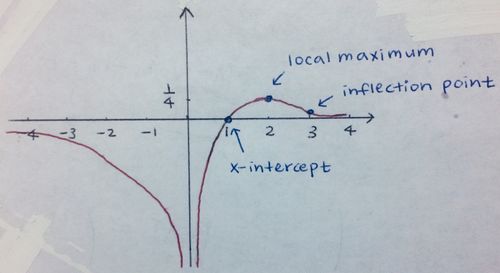Science:Math Exam Resources/Courses/MATH110/April 2016/Question 05 (i)
{{#incat:MER QGQ flag|{{#incat:MER QGH flag|{{#incat:MER QGS flag|}}}}}}
• Q1 (a) • Q1 (b) • Q1 (c) • Q1 (d) • Q2 (a) • Q2 (b) • Q2 (c) • Q2 (d) • Q3 (a) • Q3 (b) • Q3 (c) • Q4 (a) • Q4 (b) • Q4 (c) • Q4 (d) • Q5 (a) • Q5 (b) • Q5 (c) • Q5 (d) • Q5 (e) • Q5 (f) • Q5 (g) • Q5 (h) • Q5 (i) • Q6 (a) • Q6 (b) • Q7 • Q8 (a) • Q8 (b) • Q8 (c) • Q8 (d) • Q9 (a) • Q9 (b) • Q10 •
Question 05 (i) |
|---|
|
Let . (i) Make a large sketch of the graph of the function . Make sure you identify the -coordinate of any intercepts as well as local extreme values and inflection points, if they exist. |
|
Make sure you understand the problem fully: What is the question asking you to do? Are there specific conditions or constraints that you should take note of? How will you know if your answer is correct from your work only? Can you rephrase the question in your own words in a way that makes sense to you? |
|
If you are stuck, check the hint below. Consider it for a while. Does it give you a new idea on how to approach the problem? If so, try it! |
Hint |
|---|
|
Based on what we attained in last few questions, e.g. increasing, decreasing intervals; concave up and concave down, inflection, etc. we can draw a rough graph. |
|
Checking a solution serves two purposes: helping you if, after having used the hint, you still are stuck on the problem; or if you have solved the problem and would like to check your work.
|
{{#incat:MER CT flag||
}}


















